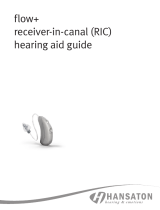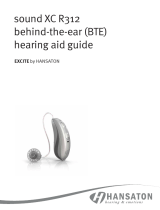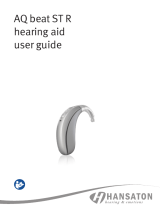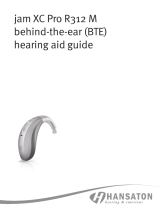Page is loading ...

sound FS R
hearing aid guide
sound FS R
sound FS R myChoice

This user guide applies to the following models:
Hearing aids
sound FS R
sound FS R
sound FS R
sound FS R
sound FS R
sound FS R myChoice
If no box is checked and you do not know the model
of your hearing aid, please ask your hearing care
professional.
Your hearing aids operate between 2.4GHz–
2.48GHz frequency range. When flying please check
if flight operator requires devices to be switched into
flight mode, see chapter 11.
Your hearing aid details
Hearing aid models Earpieces
c sound FS R 9/7/5/3/1 c Dome
c sound FS R myChoice c SlimTip
c cShell
Battery
c Size 312

Quick guide
2 beeps every
30 minutes
Low battery warning Battery size
312
On/O
Multi-function button
On O Open
Multi-function button
Your hearing aids come with a multi-function
button that allows you to adjust
them. The multi-function button
on your hearing aids can be both
a volume control and a program
control. You may also use the multi-
function button to accept and reject calls to
your paired mobile phone.
Phone calls: If paired with a Bluetooth®
enabled phone, a short press will accept and
a long press will reject an incoming call.
On/O: Close the battery door to turn on your
hearing aids, partly open the door to turn o
your hearing aids.
Enter flight mode: With hearing aid turned
o, hold down the lower push button on the
hearing aid while closing the battery door, and
keep the button pushed down for seconds.

Thank you
Thank you for choosing these hearing aids.
Please read the user guide carefully to make
sure that you understand and get the best out
of your hearing aids. Training is not required
for handling of this device. A hearing care
professional will help set up the hearing aids to
your individual preferences during the tting /
sales consultation.
For more information regarding features,
benets, setup, use and maintenance or repairs
of your hearing aid and accessories – contact
your hearing care professional or manufacturer
representative. Additional information can be
found in the specication sheet of your product.
Table of contents
1. Parts of the hearing aid .......................................................... 4
2. Turning your hearing aids onando ..................................... 6
3. Putting your hearing aids on your ears ................................... 7
4. Removing the hearing aids from your ears ............................. 9
5. Le and right hearing aid markers ....................................... 10
6. Multi-function button ............................................................11
7. Battery information ...............................................................14
8. Connectivity overview .......................................................... 17
9. Initial pairing ........................................................................ 18
10. Phone calls ......................................................................... 20
11. Flight mode ......................................................................... 24
12. Using the HANSATON streamremote App .......................... 26
13. Operating, transport and storage conditions ..................... 27
14. Care and maintenance ........................................................ 29
15. Exchanging the earwax protection ..................................... 32
16. Service and warranty .......................................................... 36
17. Compliance information ...................................................... 38
18. Information and explanation of symbols ............................41
19. Troubleshooting guide ........................................................ 45
20. Important safety information ............................................. 50
Tinnitus masker ................................................................69

4 5
1. Parts of the hearing aid
1 Wire - connects the speaker unit to your
hearingaids
2 Microphones - sound enters your hearing aids
through the microphones
3 Multi-function button - switches between
listening programs, changes the volume level,
and accepts or rejects mobile phone calls
depending on your customized tting
4 Battery door (on & o) - close the door to turn on
your hearing aids, partly open the door to turn o
your hearing aids. Opening the door all the way
gives you access to change the battery
5 Dome - holds the speaker unit in place in your ear
canal
6 Retention piece - helps prevent the dome and
speaker unit from moving out of the ear canal
7 Speaker unit - amplies the sound and sends it
directly into the ear canal
8 Custom mold - holds the hearing aids in place
sound FS R312 hearing aids
2
2
3
4
5
1
6
7
8
1
2
2
3
4
Possible earpieces
cShell SlimTip Dome

6 7
3. Putting your hearing aids on your
ears
Your hearing aids will be color-coded with a
marking on the outside of the hearing aid:
red = right ear; blue = le ear.
Hearing aids with domes
1. Place the hearing aid over
the top of your ear.
2. Hold the wire where it
attaches to the dome and
gently push the dome
into your ear canal. The
wire should lie flush
against your head and not
stick out.
3. If there is a retention
piece, place it in your ear
so it rests at the bottom
of the opening of your ear
canal.
3.
1.
2.
2. Turning your hearing aids
onando
The battery door acts as an on
and o switch.
1. On: Close the battery door
fully.
It may take ve seconds
before the hearing aids
turn on. Your hearing care
professional can increase the
start up delay if required.
2. O: Partially open the
battery door
3. Open: Fully open the battery
door to access and change
the battery.
When turning your hearing
aids on and o while they are
on the ear, grasp the top and
bottom of the device with your index nger and
thumb. Use the index nger of your opposite
hand to open and close the battery door.
1.
3.
2.

8 9
Hearing aids with custom molds
1. Hold the custom mold
between your thumb and
index nger. The opening
should be pointing in
towards your ear canal
with the hearing aid
resting above your ear.
2. Carefully insert the
custom mold into your
ear. The mold should t
into your ear snugly and
comfortably.
3. Place the hearing aid over
the top of your ear.
1.
2.
3.
4. Removing the hearing aids from
your ears
1. Pull on the bend of the
wire and remove the
hearing aid from behind
the ear.
Labeling
The serial number and year of manufacture are
located inside the battery door.
1.

10 11
5. Le and right hearing aid markers
There is a red or blue marking on the back of the
hearing aid and on the speaker. This will tell you
if it is a le or a right hearing aid.
Blue marking
for le hearing aid.
Red marking
for right hearing aid.
6. Multi-function button
Your hearing aids come with a multi-
function button that allows you to
further adjust them. The multi-function
button on your hearing aids can be both
a volume control and a program control.
You may also use the multi-function button to
accept and reject calls to your paired mobile
phone. If the hearing aid is paired with a
Bluetooth® enabled phone, a short press on the
upper or the lower part of the button will accept
an incoming call and a long press will reject an
incoming call – refer to chapter 13.
You may also use the optional RemoteControl or
HANSATON stream remote App to control your
hearing aids.
These instructions describe the default multi-
function button settings. Your hearing care
professional may change the functionality of the
buttons. See your hearing care professional for
more information.
Bluetooth® is a registered trademark owned by the Bluetooth SIG, Inc.

12 13
Program control
Each time you push the upper part of the button
on either hearing aid for longer than 2 seconds,
you will move to the next hearing aid program.
Your hearing aids beep to indicate which
program you are in.
Program setting Beeps
Program 1 (e.g. automatic program) 1 beep
Program 2 (e.g. speech in noise) 2 beeps
Program 3 (e.g. telephone) 3 beeps
Program 4 (e.g. music) 4 beeps
Volume control
To adjust the volume of your environment:
• Push the upper part of the button on the
hearing aid to increase the volume, and
• Push the lower part of the button on the
hearing aid to decrease the volume
As you change the volume, your hearing aids will
beep.
Volume setting Beeps
Suggested volume level 1 beep
Turning volume up short beep
Turning volume down short beep
Maximum volume level 2 beeps
Minimum volume level 2 beeps

14 15
7. Battery information
Low battery warning
Two long beeps indicate the hearing aid battery
is low. Aer the low battery warning, sounds
may not be as clear. This is normal and can be
xed by changing the batteries.
If you can’t hear the low battery warning, your
hearing care professional can change its pitch or
loudness.
Your hearing aids are designed to generate a
low battery warning every 30minutes until you
change the batteries, but depending on the
condition of the batteries, they may die before
another low battery warning occurs. Therefore,
it is recommended that the batteries are
replaced as soon as possible once you hear the
low battery warning.
Replacing the battery
1. Gently swing out the battery
door with your ngernail.
2. Push the battery with your
ngernail towards the open
side, and remove.
3. Insert the new battery into
the battery compartment
with the plus (+) sign on the
battery facing the same way
as the battery indicator on
the battery door. This will
ensure that the battery door
closes properly.
If the battery is inserted
incorrectly, the hearing aids
will not turn on.
4. Close the battery door.
1.
2.
3.
4.

16 17
Caring for batteries
• Always discard batteries in a safe and
environmentally friendly way.
• To prolong battery life, remember to turn your
hearing aids o when not in use, especially
when asleep.
• Remove the batteries and keep the battery
door open while hearing aids are not being
worn, especially when asleep. This will allow
internal moisture to evaporate.
8. Connectivity overview
The illustration below shows some of the
connectivity options available for your hearing
aids.
Please see the user guide that came with
your accessory for more information. Please
contact your hearing care professional to get a
TVConnector, Remote Control, PartnerMic or
Roger accessories.
Bluetooth®
enabled devices
TV Connector
connected to TV*
PartnerMic Remote control
*The TV Connector can be connected to any audio source such
asaTV, PC or hi- system.

18 19
9. Initial pairing
1. On your phone, go to your settings menu to
ensure Bluetooth® is on and to search for
Bluetooth enabled devices.
2. Turn your hearing aids on by
closing the battery door. Your
hearing aids will remain in
pairing mode for 3 minutes.
3. Your phone will show a list of
found Bluetooth enabled devices. Select your
hearing aid from the list to simultaneously
pair both hearing aids. You will hear a melody
when your phone has been successfully
paired to your hearing aids.
It is only necessary to perform the pairing
procedure once with each Bluetooth enabled
phone.
Consult your phone user guide for instructions
on pairing a Bluetooth device with your phone.
Bluetooth® is a registered trademark owned by the Bluetooth SIG, Inc.
Connecting to your mobile phone
Aer your hearing aids have been paired to your
phone, they will automatically connect again
when your phone and hearing aids are turned on
and in range. This can take up to 2 minutes.
The connection will be maintained as long as
the phone remains ON and within a range of up
to 10 m (30 ).
To switch a call between your hearing aids and
the speaker on your mobile phone, select the
audio source you would like from your phone.
If you are not sure how to do this, consult the
instruction manual that came with your mobile
phone.

20 21
10. Phone calls
Your hearing aids allow direct communication with
Bluetooth® enabled devices. When paired and
connected to a phone, you will hear notications,
incoming call notication and the caller’s voice
directly in your hearing aids. Phone calls are
“hands-free”, this means your voice is picked up
by the hearing aid’s microphones and transmitted
back to the phone. Two active Bluetooth devices
such as a phone can be connected to your hearing
aids, with support for additional pairings.
Caller’s voice
Your voice
Making a phone call
Enter the phone number and press the dial
button. You will hear the dialing tone through
your hearing aids. Your voice is picked up by the
hearing aid microphones and transmitted to the
phone.
You do not need to hold your mobile phone close
to your mouth, your voice is transmitted through
the hearing aids to your mobile phone.

22 23
Right
short push
< 2 sec
Accepting a phone call
When receiving a call, in-coming call notication
will be heard in the hearing aids (e.g. ring tone or
voice notication).
The call can be accepted by a short press on the
upper or lower part of the multi-function button
on the hearing aid (less than 2 seconds) or
directly on your phone.
Ending a phone call
A call can be ended by a long press on the upper
or lower part of the multi-function button on the
hearing aid (more than 2 seconds) or directly on
your phone.
Rejecting a phone call
An incoming call can be rejected by a long press
on the upper or lower part of the multi-function
button on the hearing aid (more than 2 seconds)
or directly on your phone.
Right
long push
> 2 sec

24 25
11. Flight mode
Your hearing aids operate between 2.4 GHz–
2.48 GHz frequency range. When flying some
operators require all devices to be switched
into flight mode. Entering flight mode will not
disable normal hearing aid functionality, only
the Bluetooth connectivity functions.
Entering flight mode
To disable the Bluetooth wireless function and
enter flight mode:
1. Open the battery door.
2. With the hearing
aid turned o, hold
down the lower push
button on the hearing
aid while closing the
battery door, and keep
the button pushed
down for seconds.
2.
1.
Exiting flight mode
To enable the Bluetooth wireless
function and to exit flight mode:
1. Open the battery door.
2. Close the battery door.
1.
2.

26 27
12. Using the HANSATON
streamremote App
Compatibility information
The HANSATON stream remote App can be used on
phones with Bluetooth Low Energy (LE) capability.
Please nd phone compatibility details on:
hansaton.com/support
Please nd the instruction for use on
hansaton.com/user-guides
Install HANSATON stream remote App
for iPhone users, please scan the code:
Install HANSATON stream remote App
for
Android OS users, please scan the
code:
iPhone® is a trademark of Apple Inc.,
registered in the U.S. and other countries.
iOS® is a registered trademark or trademark of Cisco Systems, Inc. and/or
its aliates in the United States and certain other countries.
Android™ is a trademark of Google LLC.
13. Operating, transport and storage
conditions
The product is designed such that it functions
without problems or restrictions if used as
intended, unless otherwise noted in these user
guides.
Please ensure to use, transport and store the
hearing aids according to the following conditions:
Use Transport Storage
Temperature +5° to +40°C
(41° to 104°F)
-20° to +60°C
(-4° to 140°F)
-20° to +60°C
(-4° to 140°F)
Humidity 0% to 85%
(non
condensing)
0% to 93%
(non
condensing)
0% to 93%
(non
condensing)
Atmospheric
pressure
500 hPa to
1060hPa
500 hPa to
1060hPa
500 hPa to
1060hPa

28 29
These hearing aids are classied as IP68. This
means that they are water and dust resistant
and designed to withstand daily life situations.
They can be worn in the rain but should not be
fully submerged in water or used when taking
a shower, swimming or other water activities.
These hearing aids should never be exposed
to chlorinated water, soap, salt water or other
liquids with a chemical content.
If the device has been subject to storage
and transport conditions outside of the
recommended use conditions, wait 15 minutes
before starting the device.
14. Care and maintenance
Expected service life:
The hearing aids have the expected service life
of ve years. The devices are expected to remain
safe for use for this duration.
Commercial service period:
Routine and diligent care of your hearing aids
will contribute to the outstanding performance
for the duration of the expected service life of
your devices.
Sonova AG will provide a minimum ve year
repair service period aer the respective
hearing aid and essential components have
been phased out of the manufacturer’s product
portfoio.

30 31
General information
Before using hair spray or applying cosmetics,
you should remove your hearing aid from your
ear, because these products may damage it.
Your hearing aids are resistant to water, sweat
and dust under the following conditions:
• Aer exposure to water, sweat or dust, the
hearing aid is cleaned and dried.
• The hearing aid is used and maintained as
described in this user guide.
Daily
Hearing aid:
Inspect the earpiece or dome for earwax and
moisture deposits and clean the surfaces with
a lint-free cloth. Never use cleaning agents such
as household detergents, soap, etc. for cleaning
your hearing aid. It is not recommended to rinse
with water. If you need to clean your hearing aid
intensively, ask your hearing care professional
for advice and information on lters or drying
methods.
Weekly
Hearing aid:
Clean the earpiece or dome with a so, damp
cloth or with a special cleaning cloth for
hearing aids. For more in-depth maintenance
instructions, please see your hearing care
professional.

32 33
15. Exchanging the earwax protection
Your hearing aid is equipped with an earwax
protection to protect the speaker from earwax
damage.
Please check the earwax protector regularly and
exchange it if it looks dirty or if the hearing aid
volume or sound quality is reduced. The earwax
protection should be replaced every four to eight
weeks on a regular receiver.
Removing the earpiece or dome from the
speaker
1. Remove the earpiece or
dome from the speaker
by holding the speaker
in one hand and the
earpiece or dome in the
other.
2. Gently pull o the
earpiece or dome to
remove.
3. Clean the speaker
with a lint-free cloth.

34 35
Exchanging the earwax protection with
CeruShield™ Disk
1.
Gently rotate the CeruShield
Disk in the direction indicated
by the arrows until a free
opening appears under the
bin icon.
2. To remove a used earwax
protector carefully insert the
speaker into the free opening
(under bin icon) until it clicks.
Aer the click you will see the
used earwax protector in the
opening below the bin icon.
3. To insert a new earwax
protector, carefully insert
the speaker into the opening
where the new earwax
protector is visible (opposite
the bin icon) until it clicks.
Aer the click you will see the
opening below is empty and
the new earwax protector is
now inside the speaker.
1.
2.
3.
1. Hold the speaker in one
hand and the earpiece or
dome in the other.
2. Slide the earpiece or
dome over the speaker
sound outlet.
3. The speaker and the
earpiece or dome should
t perfectly together.
2.
1.
3.
Attaching the earpiece or dome to the
speaker
/










